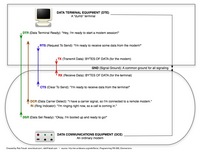I’ve been working on getting to know RS-232 Serial communications. There’s tons of acronyms, and it turns out everything relates back to “dumb” terminals talking to modems. To better understand it, I made myself this chart of the pin assignments:

(click to enlarge chart)
I also created a chart organized around the types of information passed between the two devices:

(click to enlarge chart)
The information includes definitions for each pin:
1. DCR (Data Carrier Detect): The modem turns this on when it has a carrier signal from another modem.
2. RX (Receive Data): Information sent from the modem to the dumb terminal
3. TX (Transmit Data): Information sent to the modem from the dumb terminal
4. DTR (Data Terminal Ready): The terminal turns this on when it’s ready to use the modem.
5. GND (Signal Ground): A common ground for all signaling
6. DSR (Data Set Ready): The modem turns this on when it’s ready to be used
7. RTS (Request To Send): The terminal turns this on when it’s ready to receive data
8. CTS (Clear To Send): The modem turns this on when it is ready to receive data
9. RI (Ring Indicator): The modem turns this on when it is receiving a phone call
There’s also great information in the WikiBook on Serial Programming.
